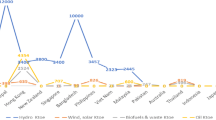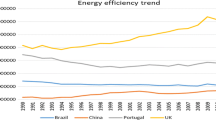Abstract
The problem of energy shortage is exacerbated by energy waste and low efficiency. Energy efficiency has become a popular research topic, but little research has been performed on the dynamic work of improving energy efficiency. In this paper, energy efficiency improving capacity is first defined to reveal this dynamic work. An evaluation index system is built before a combined weight multilayer evaluation model is applied to calculate the energy efficiency improving capacities of 15 countries from 2001 to 2010. In addition, the evolution equation for energy efficiency improvement driving force is constructed to analyze the changing trend of energy efficiency improving capacity. Next, the stages of the 15 countries’ energy efficiency improving capacities are analyzed through the inflection points. Finally, related conclusions are considered according to the analysis results.


Similar content being viewed by others
References
Abbassi, H., Mashayek, F., & Jacobs, G. B. (2014). Shock capturing with entropy-based artificial viscosity for staggered grid discontinuous spectral element method. Computers & Fluids, 98, 152–163.
Al-Obaidan, A. M., & Scully, G. W. (1992). Efficiency differences between private and state-owned enterprises in the international petroleum industry. Applied Economics, 24(2), 237–246.
Ang, B. W., Mu, A. R., & Zhou, P. (2010). Accounting frameworks for tracking energy efficiency trends. Energy Economics, 32, 1209–1219.
Bland, J. M., & Altman, D. G. (1996). Statistics notes: measurement error. BMJ, 313(7059), 1654.
Blesl, M., Das, A., Fahl, U., & Remme, U. (2007). Role of energy efficiency standards in reducing CO2 emissions in Germany: an assessment with TIMES. Energy Policy, 35(2), 772–785.
Blomberg, J., Henriksson, E., & Lundmark, R. (2012). Energy efficiency and policy in Swedish pulp and paper mills: a data envelopment analysis approach. Energy Policy, 42, 569–579.
Bose, R. (2004). Improving capacity in LMDS networks using trellis-coded modulation. EURASIP Journal on Wireless Communications and Networking, 2004(2), 365–373.
BP, 2014. http://www.bp.com/zh_cn/china/reports-and-publications.html
Burg, J. P. (1967). Maximum entropy spectral analysis. Proc. 37th. Meet. Soc. Exploration geophysicists; reprinted in modern spectrum analysis. New York: IEEE Press.
Cai, Q. Y., & Li, B. W. (2004). Improving the capacity of the Boström-Felbinger protocol. Physical Review A, 69(5), 054301.
Clinch, J. P., Healy, J. D., & King, C. (2001). Modelling improvements in domestic energy efficiency. Environmental Modelling & Software, 16(1), 87–106.
Cui, Q., & Li, Y. (2014). The evaluation of transportation energy efficiency: an application of three-stage virtual frontier DEA. Transportation Research Part D, 29, 1–11.
Cui, Q., & Li,Y. (2015). An empirical study on the influencing factors of transportation carbon efficiency: evidences from fifteen countries. Applied Energy, 141, 209–217.
Cui, Q., Kuang, H. B., Wu, C. Y., & Li, Y. (2014). The changing trend and influencing factors of energy efficiency: the case of nine countries. Energy, 64, 1026–1034.
Deng, J. L. (1982). Control problems of grey systems. System & Control Letters, 1(5), 188–294.
Elkarni, F., & Mustafa, I. (1993). Increasing the utilization of solar energy technologies (SET) in Jordan: analytic hierarchy process. Energy Policy, 21, 978–984.
Gillingham, K., & Palmer, K. (2014). Bridging the energy efficiency gap: policy insights from economic theory and empirical evidence. Review of Environmental Economics and Policy, 0(0), 1–21.
Herring, H. (2006). Energy efficiency–a critical view. Energy, 31, 10–20.
Hu, J. L., & Wang, S. C. (2006). Total-factor energy efficiency of regions in China. Energy Policy, 34, 3206–3217.
Hwang, C. L., & Yoon, K. (1981). Multiple attribute decision making: methods and applications. New York: Springer-Verlag.
Ince, E. L. (2012). Ordinary differential equations. USA: Courier Dover Publications.
Jaffe, A. B., & Stavins, R. N. (1994). The energy-efficiency gap What does it mean? Energy Policy, 22(10), 804–810.
Khademvatani, A., & Gordon, D. V. (2013). A marginal measure of energy efficiency: the shadow value. Energy Economics, 38, 153–159.
Khan, J. F., & Bhuiyan, S. M. (2014). Weighted entropy for segmentation evaluation. Optics & Laser Technology, 57, 236–242.
Kim, K., & Kim, Y. (2012). International comparison of industrial CO2 emission trends and the energy efficiency paradox utilizing production-based decomposition. Energy Economics, 34, 1724–1741.
Leng, Y., Kou, C., Zhou, N., Li, Q., Liang, Y., et al. (2012). Evaluation on transfer efficiency at integrated transport terminals through multilevel grey evaluation. Procedia - Social and Behavioral Sciences, 43, 587–594.
Lin, B., & Du, K. (2013). Technology gap and China’s regional energy efficiency: a parametric metafrontier approach. Energy Economics, 40, 529–536.
Meyer, P. S., & Ausubel, J. H. (1999). Carrying capacity: a model with logistically varying limits. Technological Forecasting and Social Change, 61(3), 209–214.
Monks, J., Ebert, J. P., Hwu, W. M. W., & Wolisz, A. (2003). Energy saving and capacity improvement potential of power control in multi-hop wireless networks. Computer Networks, 41(3), 313–330.
Mukherjee, K. (2008). Energy use efficiency in the Indian manufacturing sector: an interstate analysis. Energy Policy, 36, 662–672.
Newell, R. G., Jaffe, A. B., & Stavins, R. N. (1999). The induced innovation hypothesis and energy-saving technological change. Quarterly Journal of Economics, 114(458), 907–940.
O’Reilly, A. M. (1986). Tourism carrying capacity: concept and issues. Tourism Management, 7(4), 254–258.
Patterson, M. G. (1996). What is energy efficiency? Concepts, indicators and methodological issues. Energy Policy, 24(5), 377–390.
Pearce, D. G. (1989). Tourist development. Harlow: Longman.
Saaty, T. L. (1980). The analytic hierarchy process. New York: McGraw-Hill.
Saaty, T. L. (1990). How to make a decision: the analytic hierarchy process. European Journal of Operational Research, 48(1), 9–26.
Seidl, I., & Tisdell, C. A. (1999). Carrying capacity reconsidered: from Malthus’ population theory to cultural carrying capacity. Ecological Economics, 31(3), 395–408.
Shim, J. P. (1989). Bibliographical research on theanalytic hierarchy process (AHP). Socio-Economic Planning Sciences, 23, 161–167.
Turner, K. (2009). Negative rebound and disinvestment effects in response to an improvement in energy efficiency in the UK economy. Energy Economics, 31, 648–666.
Von Bertalanffy, L. (1968). General system theory: foundations, development, applications. New York: George Braziller.
Wang, Z., & Lu, M. (2014). An empirical study of direct rebound effect for road freight transport in China[J]. Applied Energy, 133, 274–281.
Wang, Z., Yin, F., Zhang, Y., & Zhang, X. (2012a). An empirical research on the influencing factors of regional CO2 emissions: evidence from Beijing City, China. Applied Energy, 100, 277–284.
Wang, Z. H., Zeng, H. L., Wei, Y. M., & Zhang, Y. X. (2012b). Regional total factor energy efficiency: an empirical analysis of industrial sector in China. Applied Energy, 97, 115–123.
Wang, Z., Feng, C., & Zhang, B. (2014a). An empirical analysis of China’s energy efficiency from both static and dynamic perspectives. Energy, 2014(74), 322–330.
Wang, Z., Lu, M., & Wang, J. C. (2014b). Direct rebound effect on urban residential electricity use: an empirical study in China. Renewable and Sustainable Energy Reviews, 30, 124–132.
World Bank, 2014. http://data.worldbank.org.cn/indicator/IS.SHP.GOOD.TU.
Worrell, E., Martin, N., & Price, L. (2000). Potentials for energy efficiency improvement in the US cement industry. Energy, 25(12), 1189–1214.
Worrell, E., Bernstein, L., Roy, J., Price, L., & Harnisch, J. (2009). Industrial energy efficiency and climate change mitigation. Energy Efficiency, 2, 109–123.
Wu, Q., & Wu, C. Y. (2009). Research on evaluation model of energy efficiency based on DEA. Journal of Management Sciences, 22(1), 103–112 (in Chinese).
Xie, Y., & Mao, Z. (2012). Evaluation of residential energy-saving buildings based on grey relational analysis method. Procedia Engineering, 29, 3149–3153.
Xu, S. (1988). Principle of analytic hierarchy process. Tianjin: Tianjin University Press (in Chinese).
Zhou, P., Ang, B. W., & Poh, K. L. (2008). A survey of data envelopment analysis in energy and environmental studies. European Journal of Operational Research, 189(1), 1–18.
Acknowledgments
This research is funded by the National Nature Science Foundation of China (NO.71403034; NO.71273037; NO.71320107006).
Author information
Authors and Affiliations
Corresponding author
Appendix
Appendix
Rights and permissions
About this article
Cite this article
Cui, Q., Li, Y. An empirical study on energy efficiency improving capacity: the case of fifteen countries. Energy Efficiency 8, 1049–1062 (2015). https://doi.org/10.1007/s12053-015-9337-3
Received:
Accepted:
Published:
Issue Date:
DOI: https://doi.org/10.1007/s12053-015-9337-3




